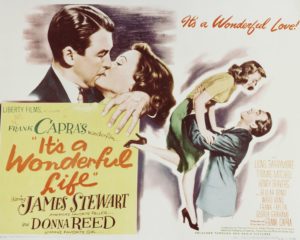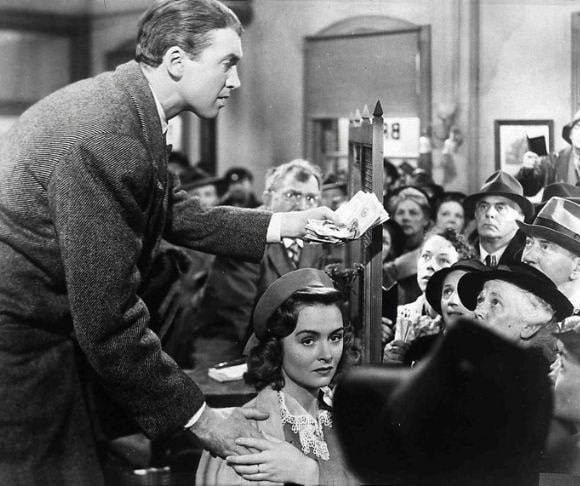It is Christmastime. As you turn on the television, with a glass of spiked egg nog, surrounded by wrapping paper that you are too lazy to chuck in the black garbage bags, you are more than likely to see one of three motion pictures: Die Hard, A Christmas Story, and perhaps the greatest holiday movie ever produced, It’s a Wonderful Life. The iconic 1946 film – starring the incomparable James Stewart (George Bailey), the lovely Donna Reed (Mary Bailey), and the legendary Lionel Barrymore (Mr. Potter) – is must-watch viewing, whether on Christmas or in the middle of summer. It is a masterpiece with the Frank Capra touch. However, just because it is etched into cinema history does not mean it is immune from bad economics, which are all too common on celluloid.
Next Stop, Pottersville!

(Photo by Silver Screen Collection/Hulton Archive/Getty Images)
The key villain of the film is Mr. Potter, the money-hungry banker. When George Bailey is temporarily erased from society in one sequence, he is shown what life would be like if he never existed. The most noticeable change is that the town he was born and raised in, Bedford Falls, is now Pottersville. Essentially, it shifts from a mundane small town to a bustling place full of dance halls and bars. The former is virtuous, while the latter is odious. But even if this were the case, the change could only happen based on what the public wants. If there were no demand for billiard halls and clubs, they would eventually go out of business. Mr. Potter invested and established a thriving town through his own capital, and the investment paid dividends as he satisfied consumer demand.
Mobility is another key factor. Geographic mobility trends ballooned in the 1940s, so it is likely that, if people had loathed living in Pottersville, they would have packed up and left.
The Evil Banker
Reportedly, Capra’s mother lost her house to banks after her husband perished. Some say that Capra set out to cast a negative light on bankers, which was seen in a couple of his earlier pictures, including American Madness, featuring the great Walter Huston. Mr. Potter fit the caricature of an iniquitous banker perfectly: a lone grumpy man who only cared about money. But was Mr. Potter, and the broader banking sector, truly vile? Not quite.
First, Mr. Potter’s primary source of income is ostensibly real estate. He offers people a place to live in exchange for rent. The abodes are referred to as slums, dilapidated properties that do not provide sufficient living conditions for families. For the issue of slums and slumlords, the eminent economist Walter Block wrote in Defending the Undefendable about this type of real estate.

It’s A Wonderful Life, James Stewart and Donna Reed (Photo by FilmPublicityArchive/United Archives via Getty Images)
“Slum housing is a problem when the inhabitants live there of necessity — not wishing to remain there, but unable to afford anything better. Their situation is certainly distressing, but the fault does not lie with the landlord. On the contrary, he is providing a necessary service, given the poverty of the tenants,” Block stated.
Second, the banks are viewed as Greedy Gretchens, aiming to fleece every last penny out of their customers. However, the film fails to touch upon how critical these financial institutions have been in providing the capital for entrepreneurs – in both Pottersville and Bedford Falls – to realize their business aspirations, be it Mr. Gower’s pharmacy or Ernie’s taxicab. Because most entrepreneurs do not possess sufficient capital to start their firms, they need seeds to help grow their companies. Instead of accumulating enough funds to launch an ice cream bar, something that could require many years, the bank allows you to acquire time. The same principle applies to a business loan or a mortgage.
Third, one critical character in the movie is the bank examiner. This individual can give the thumbs up or the thumbs down to the Building & Loan’s company, which had faced financial difficulties even prior to Uncle Billy Bailey (played by the criminally underrated Thomas Mitchell) carelessly losing several thousand dollars. But, perhaps touched by the community’s camaraderie, the examiner gives it the OK. The entity had been slumping, and this is a concern when fractional-reserve banking is factored into the equation.
Is the Real Villain Fractional-Reserve Banking?
Fractional-reserve banking consists of a financial institution lending out money that customers have deposited at the bank. Ultimately, depositors and borrowers are simultaneous owners of the same cash. How does this work and how is it justified?
Proponents assert that having money lying around inside banks’ vaults would be a waste of cash that would be better utilized throughout the economy. Critics, many of which originate from the Austrian School of Economics, would describe this as a violation of property rights, and others would contend that this is a contractual agreement that cannot be executed.
Legendary economist Ludwig von Mises also suggested that this type of system produces inflation since the money is not backed by real savings. He also argued that it contributes to the boom-bust cycle because an excess of cash would lead to artificial demand stimulus
[memberzone align=”right”]Moreover, as banks are flush with an injection of cash, they can engage in risky behavior, making investments that could result in tremendous losses for low- and middle-income depositors. But the moral hazard is facilitated by the Federal Deposit Insurance Corporation (FDIC), a program established by President Franklin Delano Roosevelt that protects deposits of up to $250,000.
It’s a Wonderful Life tells us that fractional-reserve banking is merely “your money is in Joe’s house” and “a hundred others.” But while this may be true for a small-time financial institution run inside a second-floor office space, the consequences are grander for multi-national corporations and the broader economy.
Still a Great Film
Despite the lousy economics found within It’s a Wonderful Life, it is still a great picture that offers pleasant viewing – and perhaps a few tears, too – any time of the year. Capra’s filmmaking was incredible, Stewart added his charm to the film, Reed graced us with her beauty, and Barrymore morphed into an unlikable and unsympathetic heel. Plus, the supporting cast also brought something extra to the movie. Unfortunately, bad economics is found throughout cinema history, a frustrating realization for film lovers and Econ 101 students. But it does not – and should not – take away the enjoyment that you will receive from watching this timeless classic on December 25.
“Happy New Year to you … in jail!”
~ Read more from Andrew Moran.




